Analyzing Universal Health Coverage Reforms and Impacts in Thailand
VerifiedAdded on 2020/11/12
|7
|1682
|342
Report
AI Summary
This report provides an in-depth analysis of Thailand's Universal Health Coverage (UHC) implementation and its effects on the health sector. It examines the evolution of healthcare insurance programs before UHC in 2002, the political commitment and civil society engagement that facilitated its implementation, and the impact on both the supply and demand sides of healthcare. The report highlights the expansion of healthcare infrastructure, increased utilization rates, and improved health outcomes, particularly among the poor. It also discusses the shift from supply-side to demand-side financing, the increased workload on healthcare professionals, and the financial implications. The report concludes that UHC has significantly impacted healthcare services by providing free and accessible healthcare to the total population, leading to a decline in unmet health needs and increased patient satisfaction. The analysis covers the impacts and evaluates the UHC implemented in Thailand, referencing key literature and data to support its findings.
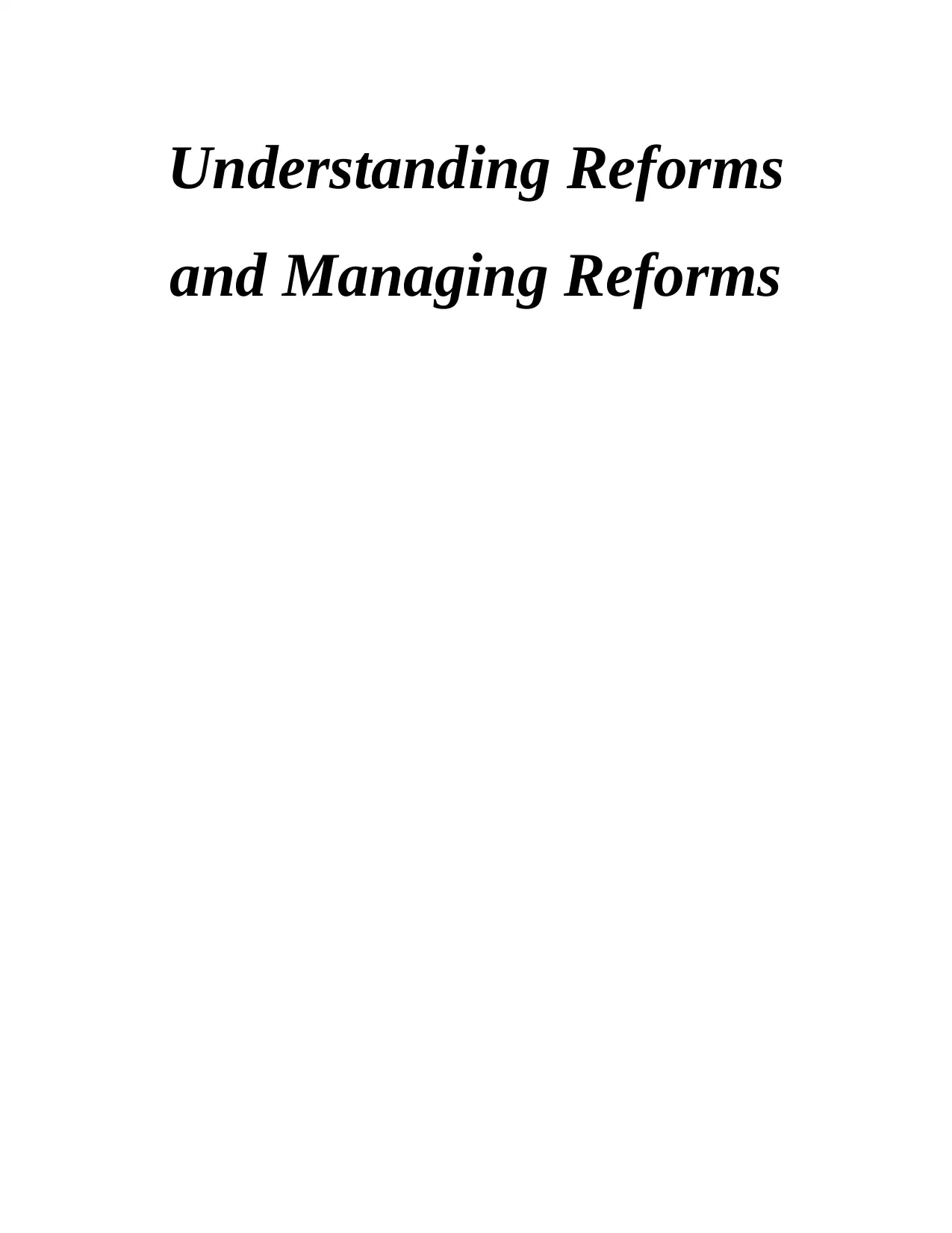
Understanding Reforms
and Managing Reforms
and Managing Reforms
Paraphrase This Document
Need a fresh take? Get an instant paraphrase of this document with our AI Paraphraser
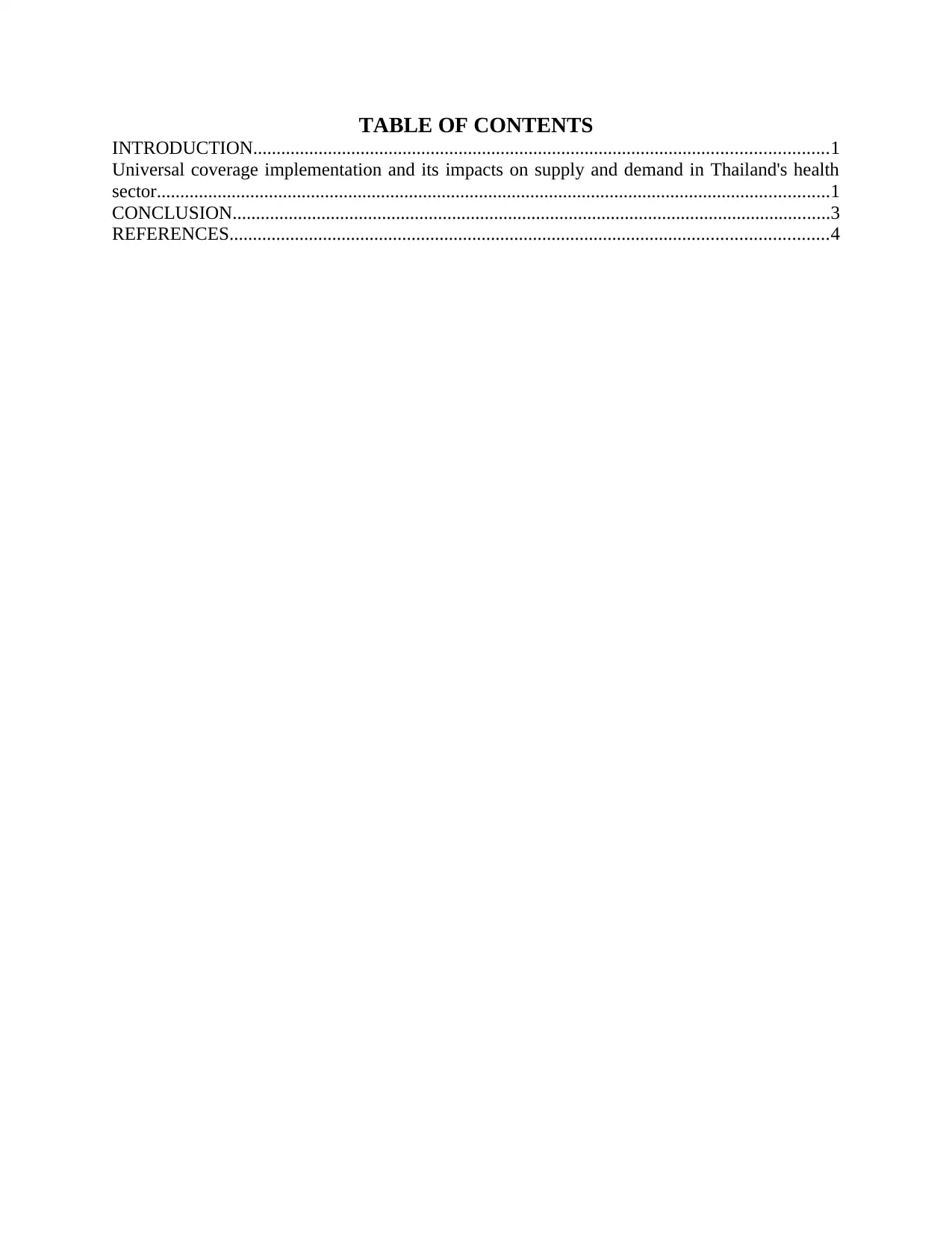
TABLE OF CONTENTS
INTRODUCTION...........................................................................................................................1
Universal coverage implementation and its impacts on supply and demand in Thailand's health
sector................................................................................................................................................1
CONCLUSION................................................................................................................................3
REFERENCES................................................................................................................................4
INTRODUCTION...........................................................................................................................1
Universal coverage implementation and its impacts on supply and demand in Thailand's health
sector................................................................................................................................................1
CONCLUSION................................................................................................................................3
REFERENCES................................................................................................................................4
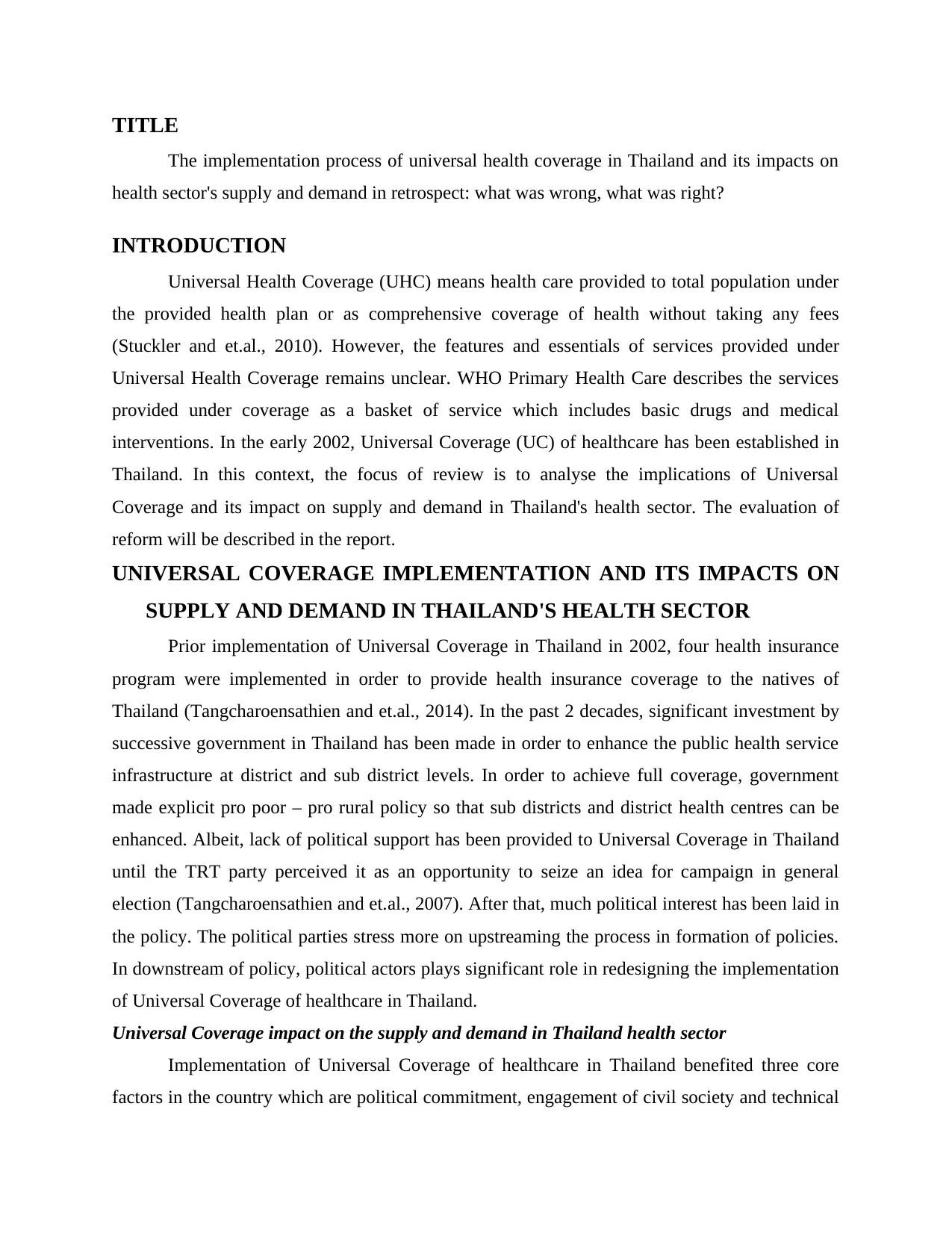
TITLE
The implementation process of universal health coverage in Thailand and its impacts on
health sector's supply and demand in retrospect: what was wrong, what was right?
INTRODUCTION
Universal Health Coverage (UHC) means health care provided to total population under
the provided health plan or as comprehensive coverage of health without taking any fees
(Stuckler and et.al., 2010). However, the features and essentials of services provided under
Universal Health Coverage remains unclear. WHO Primary Health Care describes the services
provided under coverage as a basket of service which includes basic drugs and medical
interventions. In the early 2002, Universal Coverage (UC) of healthcare has been established in
Thailand. In this context, the focus of review is to analyse the implications of Universal
Coverage and its impact on supply and demand in Thailand's health sector. The evaluation of
reform will be described in the report.
UNIVERSAL COVERAGE IMPLEMENTATION AND ITS IMPACTS ON
SUPPLY AND DEMAND IN THAILAND'S HEALTH SECTOR
Prior implementation of Universal Coverage in Thailand in 2002, four health insurance
program were implemented in order to provide health insurance coverage to the natives of
Thailand (Tangcharoensathien and et.al., 2014). In the past 2 decades, significant investment by
successive government in Thailand has been made in order to enhance the public health service
infrastructure at district and sub district levels. In order to achieve full coverage, government
made explicit pro poor – pro rural policy so that sub districts and district health centres can be
enhanced. Albeit, lack of political support has been provided to Universal Coverage in Thailand
until the TRT party perceived it as an opportunity to seize an idea for campaign in general
election (Tangcharoensathien and et.al., 2007). After that, much political interest has been laid in
the policy. The political parties stress more on upstreaming the process in formation of policies.
In downstream of policy, political actors plays significant role in redesigning the implementation
of Universal Coverage of healthcare in Thailand.
Universal Coverage impact on the supply and demand in Thailand health sector
Implementation of Universal Coverage of healthcare in Thailand benefited three core
factors in the country which are political commitment, engagement of civil society and technical
The implementation process of universal health coverage in Thailand and its impacts on
health sector's supply and demand in retrospect: what was wrong, what was right?
INTRODUCTION
Universal Health Coverage (UHC) means health care provided to total population under
the provided health plan or as comprehensive coverage of health without taking any fees
(Stuckler and et.al., 2010). However, the features and essentials of services provided under
Universal Health Coverage remains unclear. WHO Primary Health Care describes the services
provided under coverage as a basket of service which includes basic drugs and medical
interventions. In the early 2002, Universal Coverage (UC) of healthcare has been established in
Thailand. In this context, the focus of review is to analyse the implications of Universal
Coverage and its impact on supply and demand in Thailand's health sector. The evaluation of
reform will be described in the report.
UNIVERSAL COVERAGE IMPLEMENTATION AND ITS IMPACTS ON
SUPPLY AND DEMAND IN THAILAND'S HEALTH SECTOR
Prior implementation of Universal Coverage in Thailand in 2002, four health insurance
program were implemented in order to provide health insurance coverage to the natives of
Thailand (Tangcharoensathien and et.al., 2014). In the past 2 decades, significant investment by
successive government in Thailand has been made in order to enhance the public health service
infrastructure at district and sub district levels. In order to achieve full coverage, government
made explicit pro poor – pro rural policy so that sub districts and district health centres can be
enhanced. Albeit, lack of political support has been provided to Universal Coverage in Thailand
until the TRT party perceived it as an opportunity to seize an idea for campaign in general
election (Tangcharoensathien and et.al., 2007). After that, much political interest has been laid in
the policy. The political parties stress more on upstreaming the process in formation of policies.
In downstream of policy, political actors plays significant role in redesigning the implementation
of Universal Coverage of healthcare in Thailand.
Universal Coverage impact on the supply and demand in Thailand health sector
Implementation of Universal Coverage of healthcare in Thailand benefited three core
factors in the country which are political commitment, engagement of civil society and technical
⊘ This is a preview!⊘
Do you want full access?
Subscribe today to unlock all pages.

Trusted by 1+ million students worldwide
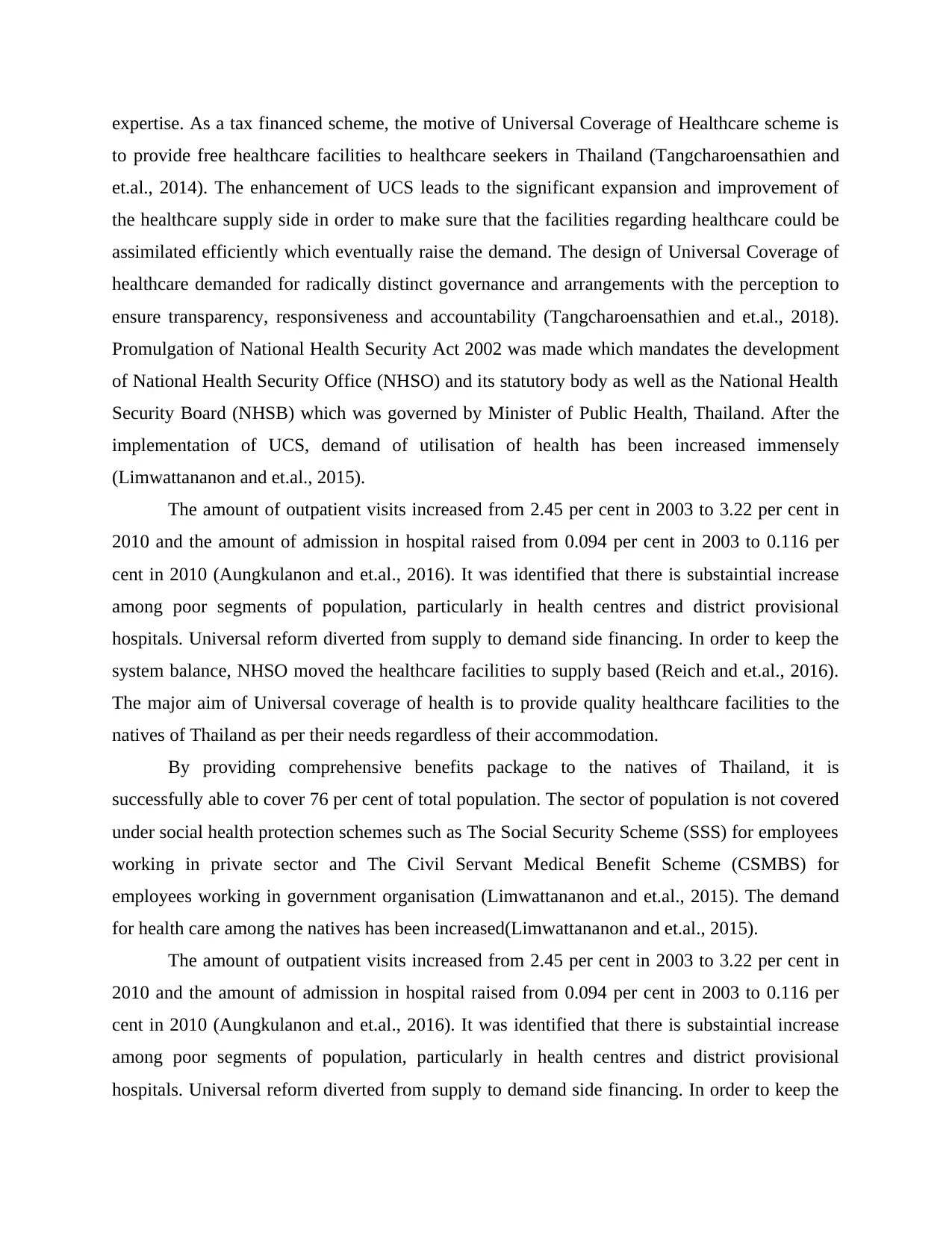
expertise. As a tax financed scheme, the motive of Universal Coverage of Healthcare scheme is
to provide free healthcare facilities to healthcare seekers in Thailand (Tangcharoensathien and
et.al., 2014). The enhancement of UCS leads to the significant expansion and improvement of
the healthcare supply side in order to make sure that the facilities regarding healthcare could be
assimilated efficiently which eventually raise the demand. The design of Universal Coverage of
healthcare demanded for radically distinct governance and arrangements with the perception to
ensure transparency, responsiveness and accountability (Tangcharoensathien and et.al., 2018).
Promulgation of National Health Security Act 2002 was made which mandates the development
of National Health Security Office (NHSO) and its statutory body as well as the National Health
Security Board (NHSB) which was governed by Minister of Public Health, Thailand. After the
implementation of UCS, demand of utilisation of health has been increased immensely
(Limwattananon and et.al., 2015).
The amount of outpatient visits increased from 2.45 per cent in 2003 to 3.22 per cent in
2010 and the amount of admission in hospital raised from 0.094 per cent in 2003 to 0.116 per
cent in 2010 (Aungkulanon and et.al., 2016). It was identified that there is substaintial increase
among poor segments of population, particularly in health centres and district provisional
hospitals. Universal reform diverted from supply to demand side financing. In order to keep the
system balance, NHSO moved the healthcare facilities to supply based (Reich and et.al., 2016).
The major aim of Universal coverage of health is to provide quality healthcare facilities to the
natives of Thailand as per their needs regardless of their accommodation.
By providing comprehensive benefits package to the natives of Thailand, it is
successfully able to cover 76 per cent of total population. The sector of population is not covered
under social health protection schemes such as The Social Security Scheme (SSS) for employees
working in private sector and The Civil Servant Medical Benefit Scheme (CSMBS) for
employees working in government organisation (Limwattananon and et.al., 2015). The demand
for health care among the natives has been increased(Limwattananon and et.al., 2015).
The amount of outpatient visits increased from 2.45 per cent in 2003 to 3.22 per cent in
2010 and the amount of admission in hospital raised from 0.094 per cent in 2003 to 0.116 per
cent in 2010 (Aungkulanon and et.al., 2016). It was identified that there is substaintial increase
among poor segments of population, particularly in health centres and district provisional
hospitals. Universal reform diverted from supply to demand side financing. In order to keep the
to provide free healthcare facilities to healthcare seekers in Thailand (Tangcharoensathien and
et.al., 2014). The enhancement of UCS leads to the significant expansion and improvement of
the healthcare supply side in order to make sure that the facilities regarding healthcare could be
assimilated efficiently which eventually raise the demand. The design of Universal Coverage of
healthcare demanded for radically distinct governance and arrangements with the perception to
ensure transparency, responsiveness and accountability (Tangcharoensathien and et.al., 2018).
Promulgation of National Health Security Act 2002 was made which mandates the development
of National Health Security Office (NHSO) and its statutory body as well as the National Health
Security Board (NHSB) which was governed by Minister of Public Health, Thailand. After the
implementation of UCS, demand of utilisation of health has been increased immensely
(Limwattananon and et.al., 2015).
The amount of outpatient visits increased from 2.45 per cent in 2003 to 3.22 per cent in
2010 and the amount of admission in hospital raised from 0.094 per cent in 2003 to 0.116 per
cent in 2010 (Aungkulanon and et.al., 2016). It was identified that there is substaintial increase
among poor segments of population, particularly in health centres and district provisional
hospitals. Universal reform diverted from supply to demand side financing. In order to keep the
system balance, NHSO moved the healthcare facilities to supply based (Reich and et.al., 2016).
The major aim of Universal coverage of health is to provide quality healthcare facilities to the
natives of Thailand as per their needs regardless of their accommodation.
By providing comprehensive benefits package to the natives of Thailand, it is
successfully able to cover 76 per cent of total population. The sector of population is not covered
under social health protection schemes such as The Social Security Scheme (SSS) for employees
working in private sector and The Civil Servant Medical Benefit Scheme (CSMBS) for
employees working in government organisation (Limwattananon and et.al., 2015). The demand
for health care among the natives has been increased(Limwattananon and et.al., 2015).
The amount of outpatient visits increased from 2.45 per cent in 2003 to 3.22 per cent in
2010 and the amount of admission in hospital raised from 0.094 per cent in 2003 to 0.116 per
cent in 2010 (Aungkulanon and et.al., 2016). It was identified that there is substaintial increase
among poor segments of population, particularly in health centres and district provisional
hospitals. Universal reform diverted from supply to demand side financing. In order to keep the
Paraphrase This Document
Need a fresh take? Get an instant paraphrase of this document with our AI Paraphraser
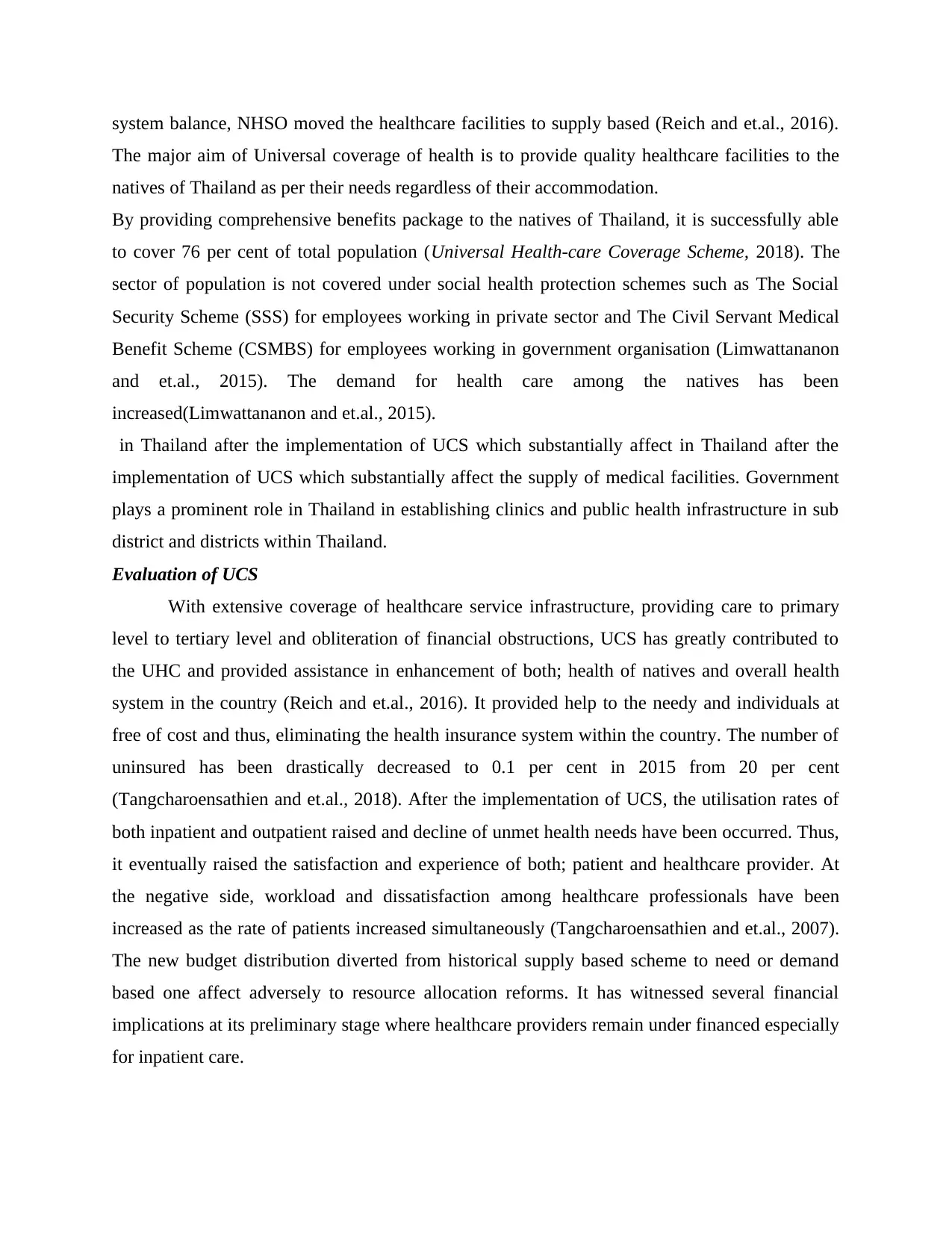
system balance, NHSO moved the healthcare facilities to supply based (Reich and et.al., 2016).
The major aim of Universal coverage of health is to provide quality healthcare facilities to the
natives of Thailand as per their needs regardless of their accommodation.
By providing comprehensive benefits package to the natives of Thailand, it is successfully able
to cover 76 per cent of total population (Universal Health-care Coverage Scheme, 2018). The
sector of population is not covered under social health protection schemes such as The Social
Security Scheme (SSS) for employees working in private sector and The Civil Servant Medical
Benefit Scheme (CSMBS) for employees working in government organisation (Limwattananon
and et.al., 2015). The demand for health care among the natives has been
increased(Limwattananon and et.al., 2015).
in Thailand after the implementation of UCS which substantially affect in Thailand after the
implementation of UCS which substantially affect the supply of medical facilities. Government
plays a prominent role in Thailand in establishing clinics and public health infrastructure in sub
district and districts within Thailand.
Evaluation of UCS
With extensive coverage of healthcare service infrastructure, providing care to primary
level to tertiary level and obliteration of financial obstructions, UCS has greatly contributed to
the UHC and provided assistance in enhancement of both; health of natives and overall health
system in the country (Reich and et.al., 2016). It provided help to the needy and individuals at
free of cost and thus, eliminating the health insurance system within the country. The number of
uninsured has been drastically decreased to 0.1 per cent in 2015 from 20 per cent
(Tangcharoensathien and et.al., 2018). After the implementation of UCS, the utilisation rates of
both inpatient and outpatient raised and decline of unmet health needs have been occurred. Thus,
it eventually raised the satisfaction and experience of both; patient and healthcare provider. At
the negative side, workload and dissatisfaction among healthcare professionals have been
increased as the rate of patients increased simultaneously (Tangcharoensathien and et.al., 2007).
The new budget distribution diverted from historical supply based scheme to need or demand
based one affect adversely to resource allocation reforms. It has witnessed several financial
implications at its preliminary stage where healthcare providers remain under financed especially
for inpatient care.
The major aim of Universal coverage of health is to provide quality healthcare facilities to the
natives of Thailand as per their needs regardless of their accommodation.
By providing comprehensive benefits package to the natives of Thailand, it is successfully able
to cover 76 per cent of total population (Universal Health-care Coverage Scheme, 2018). The
sector of population is not covered under social health protection schemes such as The Social
Security Scheme (SSS) for employees working in private sector and The Civil Servant Medical
Benefit Scheme (CSMBS) for employees working in government organisation (Limwattananon
and et.al., 2015). The demand for health care among the natives has been
increased(Limwattananon and et.al., 2015).
in Thailand after the implementation of UCS which substantially affect in Thailand after the
implementation of UCS which substantially affect the supply of medical facilities. Government
plays a prominent role in Thailand in establishing clinics and public health infrastructure in sub
district and districts within Thailand.
Evaluation of UCS
With extensive coverage of healthcare service infrastructure, providing care to primary
level to tertiary level and obliteration of financial obstructions, UCS has greatly contributed to
the UHC and provided assistance in enhancement of both; health of natives and overall health
system in the country (Reich and et.al., 2016). It provided help to the needy and individuals at
free of cost and thus, eliminating the health insurance system within the country. The number of
uninsured has been drastically decreased to 0.1 per cent in 2015 from 20 per cent
(Tangcharoensathien and et.al., 2018). After the implementation of UCS, the utilisation rates of
both inpatient and outpatient raised and decline of unmet health needs have been occurred. Thus,
it eventually raised the satisfaction and experience of both; patient and healthcare provider. At
the negative side, workload and dissatisfaction among healthcare professionals have been
increased as the rate of patients increased simultaneously (Tangcharoensathien and et.al., 2007).
The new budget distribution diverted from historical supply based scheme to need or demand
based one affect adversely to resource allocation reforms. It has witnessed several financial
implications at its preliminary stage where healthcare providers remain under financed especially
for inpatient care.
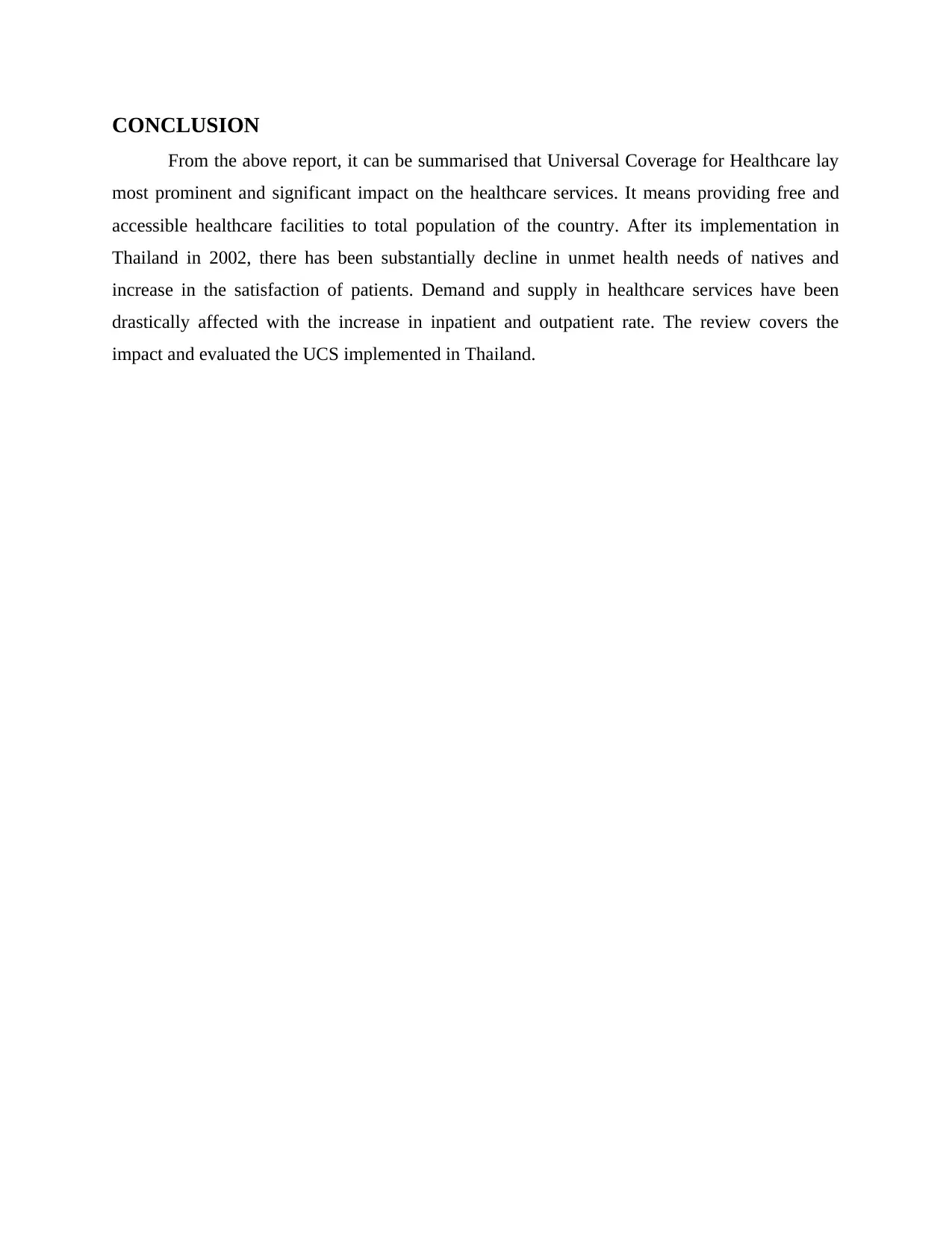
CONCLUSION
From the above report, it can be summarised that Universal Coverage for Healthcare lay
most prominent and significant impact on the healthcare services. It means providing free and
accessible healthcare facilities to total population of the country. After its implementation in
Thailand in 2002, there has been substantially decline in unmet health needs of natives and
increase in the satisfaction of patients. Demand and supply in healthcare services have been
drastically affected with the increase in inpatient and outpatient rate. The review covers the
impact and evaluated the UCS implemented in Thailand.
From the above report, it can be summarised that Universal Coverage for Healthcare lay
most prominent and significant impact on the healthcare services. It means providing free and
accessible healthcare facilities to total population of the country. After its implementation in
Thailand in 2002, there has been substantially decline in unmet health needs of natives and
increase in the satisfaction of patients. Demand and supply in healthcare services have been
drastically affected with the increase in inpatient and outpatient rate. The review covers the
impact and evaluated the UCS implemented in Thailand.
⊘ This is a preview!⊘
Do you want full access?
Subscribe today to unlock all pages.

Trusted by 1+ million students worldwide

REFERENCES
Books and Journals
Aungkulanon, S. and et.al., 2016. Post universal health coverage trend and geographical
inequalities of mortality in Thailand. International journal for equity in health, 15(1),
p.190.
Limwattananon, S. and et.al., 2015. Universal coverage with supply-side reform: The impact on
medical expenditure risk and utilization in Thailand. Journal of Public Economics, 121,
pp.79-94.
Reich, M.R. and et.al., 2016. Moving towards universal health coverage: lessons from 11 country
studies. The Lancet, 387(10020), pp.811-816.
Stuckler, D. and et.al., 2010, November. The political economy of universal health coverage.
In Background paper for the global symposium on health systems research. Geneva:
World Health Organization.
Tangcharoensathien, V. and et.al., 2007. Achieving universal coverage in Thailand: what lessons
do we learn?.
Tangcharoensathien, V. and et.al., 2014. Achieving universal health coverage goals in Thailand:
the vital role of strategic purchasing. Health policy and planning, 30(9), pp.1152-1161.
Tangcharoensathien, V. and et.al., 2018. Health systems development in Thailand: a solid
platform for successful implementation of universal health coverage. The Lancet.
Online
Universal Health-care Coverage Scheme, 2018 [Online]. Available through:<http://www.social-
protection.org/gimi/gess/RessourcePDF.action?ressource.ressourceId=54059>
Books and Journals
Aungkulanon, S. and et.al., 2016. Post universal health coverage trend and geographical
inequalities of mortality in Thailand. International journal for equity in health, 15(1),
p.190.
Limwattananon, S. and et.al., 2015. Universal coverage with supply-side reform: The impact on
medical expenditure risk and utilization in Thailand. Journal of Public Economics, 121,
pp.79-94.
Reich, M.R. and et.al., 2016. Moving towards universal health coverage: lessons from 11 country
studies. The Lancet, 387(10020), pp.811-816.
Stuckler, D. and et.al., 2010, November. The political economy of universal health coverage.
In Background paper for the global symposium on health systems research. Geneva:
World Health Organization.
Tangcharoensathien, V. and et.al., 2007. Achieving universal coverage in Thailand: what lessons
do we learn?.
Tangcharoensathien, V. and et.al., 2014. Achieving universal health coverage goals in Thailand:
the vital role of strategic purchasing. Health policy and planning, 30(9), pp.1152-1161.
Tangcharoensathien, V. and et.al., 2018. Health systems development in Thailand: a solid
platform for successful implementation of universal health coverage. The Lancet.
Online
Universal Health-care Coverage Scheme, 2018 [Online]. Available through:<http://www.social-
protection.org/gimi/gess/RessourcePDF.action?ressource.ressourceId=54059>
1 out of 7
Related Documents
Your All-in-One AI-Powered Toolkit for Academic Success.
+13062052269
info@desklib.com
Available 24*7 on WhatsApp / Email
![[object Object]](/_next/static/media/star-bottom.7253800d.svg)
Unlock your academic potential
Copyright © 2020–2025 A2Z Services. All Rights Reserved. Developed and managed by ZUCOL.




